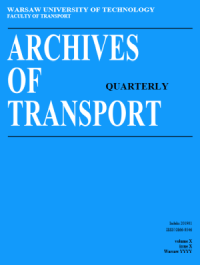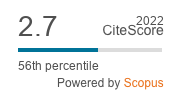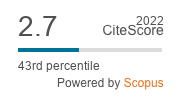The use of the risk matrix method for assessing the risk of implementing rail freight services
DOI:
https://doi.org/10.5604/01.3001.0016.1185Keywords:
rail transport, freight transport, risk matrix, adverse events, assessing of riskAbstract
The article presents a proposal for the use of a risk matrix for assessing the safety of the implementation of rail freight transport. The starting point for considerations related to risk assessment is the conditions arising from the business need and the obligation of entities operating in the railway market to ensure the safety of the implementation of freight tasks. The authors presented selected literature within the framework of the issues discussed. The layers of risk assessment, which include the analytical layer, the decision layer and the elimination layer, indicate the possibility of considering the problem of risk assessment from different perspectives. The identification of direct causes and consequences of undesirable events during the implementation of rail freight transport was also made. The article describes one of the methods of risk management which is the risk matrix. The authors stressed that the construction of a risk matrix should be preceded by an analysis of the factors that affect the safety of rail transportation. This is possible by determining their probability of occurrence and setting values for the consequences of adverse events. The article divides the assignment of levels of adverse events to a five-level risk matrix (slight, low, medium, high, very high). Also presented is a case study considering the risk assessment of rail freight transport in Poland using the risk matrix method for railway accidents in the area of railway lines. Thanks to the development of the risk matrix, a risk management strategy can be used. The last part of the article is a summary, which highlights the possibility of applying the presented approach to risk assessment among entities operating in the rail transport market.
References
Abioye, O., Dulebenets, M., Pasha, J., Kavoosi, M., Moses, R., Sobanjo, J., Ozguven, E. (2020). Accident and hazard prediction models for highway–rail grade crossings: a state-of-the-practice review for the USA. Railway Engineering Science 28 (3), 251-274. DOI: 10.1007/s40534-020-00215-w.
Ambituuni, A., Amezaga, J., Werner, D. (2015). Risk assessment of petroleum product transportation by road: A framework for regulatory improvement. Safety Science, 79, 324-335. DOI: 10.1016/j.ssci.2015.06.022.
Bałuch, H., Starczewska, M., KOW Sp. z o. o. (2011). Leksykon terminów kolejowych. Warszawa: KOW media & marketing.
Batarliene, N., Jarasuniene, A. (2014). Analysis of the accidents and incidents occurring during the transportation of dangerous goods by rail-way transport. Transport (Vilnius, Lithuania), 29(4), 395-400. DOI:10.3846/16484142.2014.983967.
Batarliene, N. (2020). Essential Safety Factors for the Transport of Dangerous Goods by Road: A Case Study of Lithuania. Sustainability (Basel, Switzerland), 12(12), 4954. DOI:10.3390/su12124954.
Bernatik, A., Rehak, D., Cozzani, V., Foltin, P., Valasek, J., Paulus, F. (2021). Integrated Environmental Risk Assessment of Major Accidents in the Transport of Hazardous Substances. Sustainability (Basel, Switzerland), 13(21), 11993. DOI:10.3390/su132111993.
Berrado, A., El-Koursi, E., Cherkaoui, A., Khaddour, M. (2011). A Framework for Risk Management in Railway Sector: Application to Road-Rail Level Crossings. The Open Transportation Journal, 5(1), 34-44. DOI: 10.2174/1874447801105010034.
Burdzik, R., Rozmus, R., Nowak, B., Młyńczak, J. (2017). Analysis of the safety of railway level crossing in the aspect of traffic ratio. Scientific Journals of the Institute of Vehicles, 4(113), 23-31.
Bureika, G., Gaidamauskas, E., Kupinas, J., Bogdevičius, M., Steišūnas, S. (2017). Modelling the assessment of traffic risk at level crossings of Lithuanian railways. Transport (Vilnius, Lithuania), 32(3), 282-290. DOI: 10.3846/16484142.2016.1244114.
Cafiso, S., A. Di Graziano, N. Di Blasi. (2006). Risk Assessment On Railway Transportation Of Hazardous Materials. WIT Transactions on Ecology and the Environment, 91, 97-106. DOI:10.2495/RISK060101.
Cieśla, M., Sobota, A., Jacyna, M. (2020). Multi-Criteria Decision Making Process in Metropolitan Transport Means Selection Based on the Sharing Mobility Idea. Sustainability (Basel, Switzerland), 12(17), 7231. DOI:10.3390/su12177231.
Conca, A., Ridella, C., Sapori, E. (2016). A Risk Assessment for Road Transportation of Dangerous Goods: A Routing Solution. Transportation Research Procedia, 14, 2890-2899. DOI:10.1016/j.trpro.2016.05.407.
De Cillis, F., De Maggio, M., Pragliola C., Setola, R. (2013). Analysis of Criminal and Terrorist Related Episodes in Railway Infrastructure Scenarios. Journal of Homeland Security and Emergency Management, 10(2), 1-30. DOI: 10.1515/jhsem-2013-0003.
Duffey, R., Saull, J. (2002). Know the Risk : Learning from Errors and Accidents: Safety and Risk In Today's Technology, Elsevier Science & Technology.
Duffey, R. (2020). Learning About Risk : Life, Death...and Money, Independently Published.
Dvorak, Z., Rehak, D., David, A., Cekerevac, Z. (2020). Qualitative Approach to Environmental Risk Assessment in Transport. International Journal of Environmental Research and Public Health, 17(15), 5494. DOI:10.3390/ijerph17155494.
Elmontsri, M. (2014). Review of the Strengths and Weaknesses of Risk Matrices. Journal of Risk Analysis and Crisis Response, 4(1), 49. DOI:10.2991/jrarc.2014.4.1.6.
European Union. (2013). Commission Implementing Regulation (EU) No 402/2013 of 30 April 2013 on the common safety method for risk evaluation and assessment and repealing Regulation (EC) No 352/2009. (L 121/8).
Grabowska–Bujna, B., Wieczorek, S., Mikulski, J. (2016). Rail Traffic Remote Control Systems Within the Areas Affected by the Occurrence of Mining Damage and Railway Safety. Tools of Transport Telematics, 264-273. DOI:10.1007/978-3-319-24577-5_26.
Grenčík, J., Galliková, J., Volna, P. (2020). A novel methodology of risk assessment for railway freight wagons. Scientific Journals of the Maritime University of Szczecin, 63(135), 17-22. DOI:10.17402/435.
Grenčík, J., Poprocký, R., Galliková, J., Volna, P. (2018). Use of risk assessment methods in maintenance for more reliable rolling stock operation. MATEC Web of Conferences, 157, 4002. DOI:10.1051/matecconf/201815704002.
GUGiK. (2022). Head Office of Geodesy and Cartography. Access: https://mapy.geoportal.gov.pl/wss/service/sdi/Przejazdy/get.
GUGiK. (2022). Head Office of Geodesy and Cartography. Access: https://services.gugik.gov.pl/uug/.
Huang, W., Zhang, Y., Kou, X., Yin, D., Mi, R., Li, L. (2020). Railway dangerous goods transportation system risk analysis: An Interpretive Structural Modeling and Bayesian Network combining approach. Reliability Engineering & System Safety, 204. 107220. DOI:10.1016/j.ress.2020.107220.
Huang, W., Zhang, Y., Yu, Y., Xu, Y., Xu, M., Zhang, R., Liu, Z. (2021). Historical data-driven risk assessment of railway dangerous goods transportation system: Comparisons between Entropy Weight Method and Scatter Degree Method. Reliability Engineering & System Safety, 205, 107236. DOI:10.1016/j.ress.2020.107236.
IEC. (2016). International Standard 61882, Hazard and Operability Studies (HAZOP) Application Guide.
ISO 31010 Risk management - Risk assessment techniques. 2.0. Geneva: IEC. (2020).
ISO Guide 73: Risk management - Vocabulary. 2.0. Vienna: ISO (2010).
IEC 60812 Failure modes and effects analysis (FMEA and FMECA). 2.0. Geneva: IEC (2019).
Izdebski, M., Jacyna-Gołda, I., Gołda, P. (2022). Minimisation of the probability of serious road accidents in the transport of dangerous goods. Reliability Engineering & System Safety, 217, 108093. DOI:10.1016/j.ress.2021.108093.
Jacyna, M., Szaciłło, L. (2017). Selected aspects of risk management in railway transport. WUT Journal of Transportation Engineering, 119, 163-178.
Jacyna, M., Semenov, I. (2020). Models of ve-hicle service system supply under information uncertainty. Eksploatacja I Niezawodnosc - Maintenance and Reliability, 22(4), 694-704. DOI:10.17531/ein.2020.4.13.
Jacyna, M., Jachimowski, R., Szczepański, E., Izdebski, M.. (2020). Road vehicle sequencing problem in a railroad intermodal terminal – simulation research. Bulletin of the Polish Academy of Sciences. Technical Sciences, 68(5), 1135-1148. DOI:10.24425/bpasts.2020.134643.
Karoń G., Żochowska, R. (2020). Problems of Quality of Public Transportation Systems in Smart Cities-Smoothness and Disruptions in Urban Traffic. In book: Modelling of the Inter-action of the Different Vehicles and Various Transport Modes, 383-414. DOI:10.1007/978-3-030-11512-8_9.
Kornaszewski, M., Pniewski. (2016). Pedicting reliability of railway traffic control devices using simulation methods. WUT Journal of Transportation Engineering, 113, pp. 241-253.
Kycko, M., Zabłocki, W. (2019). Risks in In-vestment Processes Covering Railway Traffic Control Systems. Railway Reports, 184, 85-91.
Lahuta, P., Kardoš, P., Hudáková, M. (2021). Integrated Risk Management System in Transport. Transportation Research Procedia, 55, 1530-1537. DOI:10.1016/j.trpro.2021.07.142.
Liu, X. (2016). Development of a Risk Assessment Tool for Rail Transport of Flammable Energy Resources. Final report (CAIT-UTC-NC16). New Jersey: Department of Civil and Environmental Engineering Rutgers. The State University of New Jersey.
Luxton, A., Marinov, M. (2020). Terrorist Threat Mitigation Strategies for the Railways. Sustainability (Basel, Switzerland), 12(8), 3408. DOI:10.3390/su12083408.
Marrone, S., Nardone, R., Tedesco, A., D'Amore, P., Vittorini, V., Setola, R., Mazzocca, N. (2013). Vulnerability modeling and analysis for critical infrastructure protection applications. International Journal of Critical Infrastructure Protection, 6(3-4), 217-227. DOI:10.1016/j.ijcip.2013.10.001.
MIiB. (2016). Rozporządzenie Ministra Infrastruktury i Budownictwa z dnia 16 marca 2016 r. w sprawie poważnych wypadków, wypadków i incydentów (369, Dz.U. 2016 poz.).
Murawski, J., Szczepański, E., Jacyna-Gołda, I., Izdebski, M., Jankowska-Karpa, D. (2022). Intelligent mobility: A model for assessing the safety of children traveling to school on a school bus with the use of intelligent bus stops. Eksploatacja i Niezawodność - Maintenance and Reliability, 24(4), 695-706. DOI: 10.17531/ein.2022.4.10.
PKP PLK S.A. (2022). PKP Polish Railway Lines S.A., Access: http://mapa.plk-sa.pl/.
Placido, A., Petito, C., Gallo, M., D’Acierno, L. (2017). Managing disruptions and disturbances on railway services: A real-scale case study. International Journal of Transport Development and Integration, 1(4), 695-710. DOI:10.2495/TDI-V1-N4-695-710.
PN-EN. (2018). 50126-2:2018 Railways Applications - The Specification and Demonstration of Reliability, Availability, Maintainability and Safety (RAMS) - Part 2: Systems Approach to Safety.
Rahbar, M., Bagheri, M. (2014). Risk Assessment Framework for the Rail Transport of Hazardous Materials. Transportation Research Record. Journal of the Transportation Research Board, 2411, 90-95. DOI:10.3141/2411-11.
Sanchis, I., Franco, R., Zuriaga, P., Fernández, P. (2020). Risk of increasing temperature due to climate change on operation of the Spanish rail network. Transportation Research Procedia, 45, 5-12. DOI:10.1016/j.trpro.2020.02.056.
Sitarz, M., Chruzik., Wachnik, R. (2011). The integrated managing system for safety in rail-way transport. Part 8. estimation of risk. TTS Technika Transportu Szynowego, 5-6, 89-93.
Sobota, A., Żochowska, Szczepański, E., Gołda, P. (2018). The influence of tram tracks on car vehicle speed and noise emission at four-approach intersections located on multilane arteries in cities. Journal of Vibroengineering, 20(6), 2453-2468. DOI:10.21595/jve.2018.20087.
Szaciłło, L. (2021). Model Oceny Ryzyka Realizacji Kolejowych Przewozów Towarowych: Rozprawa Doktorska. (Risk assessment model for the implementation of rail freight).
Szaciłło, L., Jacyna, M., Szczepański, E., Izdebski, M. (2021). Risk assessment for rail freight transport operations. Eksploatacja i Niezawodność - Maintenance and Reliability, 23(3), pp. 476-488. DOI:10.17531/ein.2021.3.8.
Tavasszy, L., De Jong, G. (2013). Modelling Freight Transport (1st ed., Elsevier insights). Saint Louis: Elsevier. DOI:10.1016/C2012-0-06032-2.
Tubis, A., Werbińska-Wojciechowska, S. (2017). Risk assessment issues in the process of freight transport performance. Journal of KONBiN, 42(1), 235-253. DOI:10.1515/jok-2017-0027.
UTK. (2003). The Railway Transport Act of March 28, 2003. Access: https://utk.gov.pl/en/market-regulation-and-l/railway-transport-act/19018,Nonbinding-Translation-of-the-Railway-Transport-Act-2003.html (2022).
UTK. (2022). The Office of Rail Transport. Access: https://dane.utk.gov.pl/sts/infrastruktura/obiekty-infrastruktury/18003,Obiekty- in-frastruktury-uslugowej-z-podzialem-na-rodzaj-swiadczonych-uslug.html.
UTK. (2020). The Office of Rail Transport. Access: https://utk.gov.pl/pl/dokumenty-i-formularze/opracowania-urzedu-tran/19252,Sprawozdanie-ze-stanu-bezpieczenstwa-ruchu-kolejowego-2021.html.
Downloads
Published
Issue
Section
License
Copyright (c) 2024 Archives of Transport journal allows the author(s) to hold the copyright without restrictions.

This work is licensed under a Creative Commons Attribution 4.0 International License.











